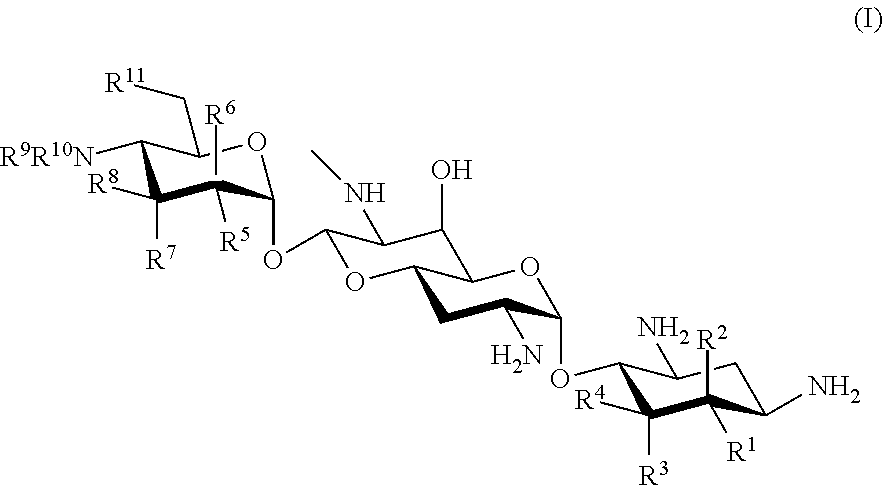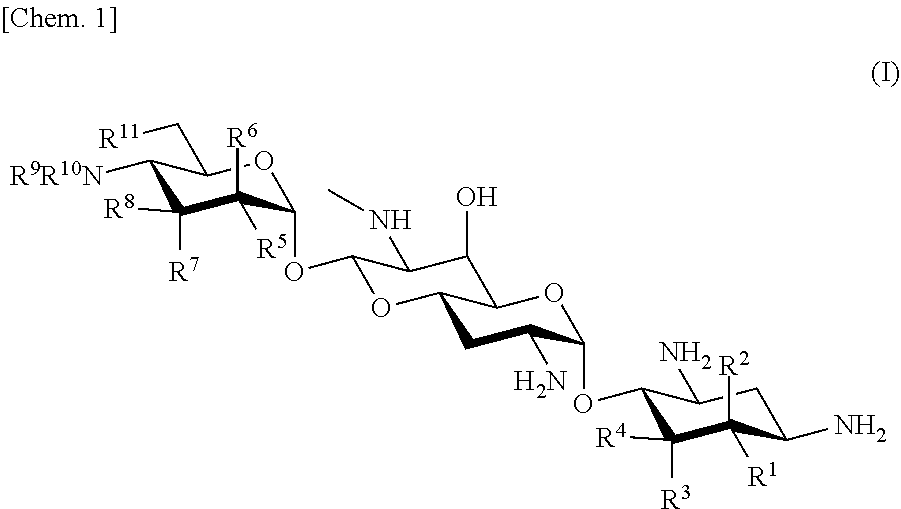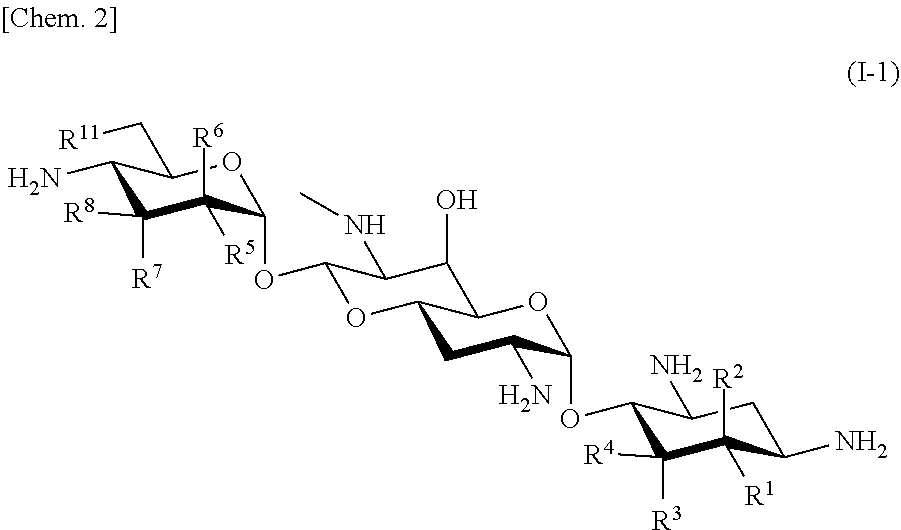Effective aminoglycoside antibiotic for multidrug-resistant bacteria
a technology of aminoglycoside and antibiotic, which is applied in the field of new aminoglycoside antibiotics, can solve the problems of not currently available medicine including these antibacterial agents, the development of such medicines also faces difficulties, and the emerging arbekacin-resistant bacteria pose problems in clinical practice, so as to achieve the effect of a wide antibacterial spectrum
- Summary
- Abstract
- Description
- Claims
- Application Information
AI Technical Summary
Benefits of technology
Problems solved by technology
Method used
Image
Examples
example 1
of 4″-N-benzyl-1,3,2′-tris-N-(benzyloxycarbonyl)-7′-N,6′-O-carbonylapramycin (A5) and 4″-N-methylapramycin (A4-a)
[0331]
Example 1-(i): Synthesis of 4″-N-benzyl-1,3,2′-tris-N-(benzyloxycarbonyl)-7′-N,6′-O-carbonylapramycin (A5)
[0332]A solution prepared by adding 15 ml of triethylamine and 6 ml of benzaldehyde to a solution of 20.4 g (21 mmol) of the compound represented by formula (A3) described in the US patent 2013 / 0165395A1 dissolved in 200 ml of methanol was stirred at room temperature for 2 hours. Then, after adding 1.6 g of NaBH4, the resultant mixture was subjected to reaction at room temperature for 10 minutes. The reaction solution was concentrated under reduced pressure and washed with water. After drying, the resultant residue was washed with isopropyl ether to give 21.2 g (95%) of the title compound (A5) as a white solid.
[0333]MS (ESI) m / z: 1081 (M+Na)+.
example 1-(
ii): Synthesis of 4″-N-methylapramycin (A4-a)
[0334]A mixture prepared by adding 0.1 ml of 37% formalin solution and 10 mg of NaBH3CN to a solution of 550 mg (0.51 mmol) of the compound (A5) of Example 1-(i) dissolved in 10 ml of 10% acetic acid-methanol was subjected to reaction at room temperature for 13 hours. After completion of the reaction, the mixture was concentrated under reduced pressure and washed with water. After drying, the residue was dissolved in 5.2 ml of 50% aqueous 1, 4-dioxane and 0.5 ml of acetic acid and palladium black were added to the solution, and catalytic reduction was performed in a hydrogen atmosphere at room temperature for 10 hours. After completion of the reaction, the reaction mixture was neutralized with NH4OH and concentrated under reduced pressure after filtration. After drying, the residue was dissolved in 2.5 ml of water and the resulting mixture was heated to 110° C., to which 2.5 ml of 1 N aqueous potassium hydroxide was added. The mixture was...
example 2
of 4″-N-(3-aminopropyl)apramycin (A4-b)
[0336]
[0337]The title compound (A4-b) [87.1 mg (46%)] was obtained by a method similar to Example 1-(ii) using 333 mg (0.32 mmol) of the compound (A5) of Example 1-(i) and 80 mg of 3-[(benzyloxycarbonyl)amino]propionaldehyde.
[0338]MS (ESI) m / z: 597 (M+1)+; 1H NMR (25% ND3-D2O, 500 MHz): δ 1.91-2.05 (3H, m, 4″-NH2Pr(β) and H-3′ ax), 2.94-3.09[6H, m, H-1 and 7′ and 4″-NH2Pr(α, γ)], 5.28 (1H, d, H-1″) and 5.67 (1H, d, H-1′).
PUM
 Login to View More
Login to View More Abstract
Description
Claims
Application Information
 Login to View More
Login to View More - R&D
- Intellectual Property
- Life Sciences
- Materials
- Tech Scout
- Unparalleled Data Quality
- Higher Quality Content
- 60% Fewer Hallucinations
Browse by: Latest US Patents, China's latest patents, Technical Efficacy Thesaurus, Application Domain, Technology Topic, Popular Technical Reports.
© 2025 PatSnap. All rights reserved.Legal|Privacy policy|Modern Slavery Act Transparency Statement|Sitemap|About US| Contact US: help@patsnap.com



